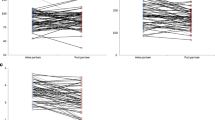Abstract
Introduction
The objective of this study was to determine the normal anal position index (API) in neonates and in a group of older children with chronic constipation, and to identify the incidence of anterior ectopic anus (AEA) in the two groups.
Materials and methods
A prospective random study was carried out in two European hospitals determining the API in 1,012 neonates (529 in Group A, and 483 in Group B) and in 64 children suffering chronic constipation of ages between 3 months and 12 years (Group C). The API is defined as the ratio between the fourchette-anal and fourchette-coccygeal distances in girls and the scroto-anal and scroto-coccygeal distances in boys. The gestational age, weight, meconium evacuation and anal calibre were recorded in Groups A and B, and age, sex, and API in Group C. Statistical comparisons were made using Student’s t test and Welch’s t test for independent sample groups.
Results
The mean API in Group A was 0.53 ± 0.06 in males and 0.40 ± 0.05 in females, and in Group B 0.51 ± 0.06 in males and 0.39 ± 0.08 in females, with significant differences between the sexes (p < 0.0001) in both groups; 1.7% of the neonates in Group A and 2.4% of Group B presented AEA. 4/13 newborns females with AEA presented with severe constipation during their first months of life. For the 64 patients in Group C: 59.3% were female; the mean API was 0.47 ± 0.1 in males and 0.36 ± 0.1 in females (p < 0.0001). The incidence of AEA was 47% in females and 35% in males.
Conclusions
In the neonates (Groups A and B), the position of the anus in the perineum was more anterior in females than in males (p < 0.0001); 31% of the newborns females with AEA presented with constipation in their first months of life. In the Group C patients, there was a high incidence of AEA, especially in the females, and we consider it to be the probable cause of this defecation disorder.

Similar content being viewed by others
References
Herek O, Polat A (2004) Incidence of anterior displacement of the anus and its relationship to constipation in children. Surg Today 34:190–192
Schuster T, Joppich I, Schneider K, Jobst G (2000) A computerised vector manometry study of the so-called ectopic anus. Pediatr Surg Int 16:8–14
Peña A (2004) Comments on anterior ectopic anus. Pediatr Surg Int 20:902
Thambidorai CR, Raghu R, Zulfiqar A (2008) Magnetic resonance imaging in anterior ectopic anus. Pediatr Surg Int 24:161–165
Genç A, Taneñi C, Tansug N, Kasirga E, Yilmaz D, Kücükoglu T et al (2002) Evaluation of the location of the anus by a modified technique in the neonate. J Pediatr Surg 37:80–82
Herek O (2001) Anterior ectopic anus: an accurate definitive term for choice of treatment? Pediatr Surg Int 17:501
Chan WT, Lee HC, Wang WN, Yeung CY, Jiang CB (2009) Determination of the normal position of the anus in Taiwanese infants. Pediatr Neonatol 50:158–161
Bill AH Jr, Johnson RJ, Foster RA (1958) Anteriorly placed rectal opening in the perineum ectopic anus: a report of 30 cases. Ann Surg 147:173–179
Hendren WH (1978) Constipation caused by anterior location of the anus and its surgical correction. J Pediatr Surg 13:505–512
Leape LL, Ramnofsky ML (1978) Anterior ectopic anus: a common cause of constipation in children. J Pediatr Surg 13:627–630
Ishitani MB, Rodgers BM (1991) Anteriorly displaced anus: an unrecognised cause of chronic constipation. Pediatr Surg Int 6:217–230
Fukunaga K, Kimura K, Lawrencw RT, Phearman LA, Loening-Baucke V (1996) Anteriorly located anus: is constipation caused by abnormal location of the anus? J Pediatr Surg 31:245–246
Bar-Maor JA, Eitan A (1987) Determination of the normal position of the anus (with reference to idiopathic constipation). J Pediatr Gastroenterol Nutr 6:559–561
Skandalakis JE, Kingsnorth AN, Colborn GL, Weidman TA (2004) Large intestine and anorectum. In: Skandalakis JE, Colborn GL, Weidman TA (eds) Skandalakis`s surgical anatomy: the embryology and anatomy basis of modern surgery. Paschalidis Medical Publications, Athens, pp 899–914
Reisner SH, Sivan Y, Nitzan M, Merlob P (1984) Determination of anterior displacement of the anus in newborn infants and children. Pediatrics 73:216–217
Kauvar DR, Boley SJ (1993) Anorectal continence and management of constipation. In: Ascchraft KW, Holder TM (eds) Pediatric Surgery, 2nd edn. Saunders, Philadelphia, pp 402–409
Ottolenghi A, Sulpasso M, Bianchi S, Bettili G, Salloun A, Liber H (1994) Ectopic anus in childhood. Eur Pediatr Surg 4:145–150
Haber HP, Warmann SW, Fuchs J (2008) Transperineal sonography of the anal sphincter complex in neonates and infants: differentiation of anteriorly displaced anus from low-type imperforate anus with perineal fistula. Ultraschall Med 29:383–387
Mohta MR, Goel MR (2004) Determination of anal position index. Indian Pediatr 41:91–92
Davari HA, Hosseinper M (2006) The anal position index: a simple method to define the normal position of the anus in neonate. Acta Paediatr 95:877–880
Rerksuppaphol S, Rerksuppaphol L (2008) Normal anal position index in Thai newborns. Med Assoc Thai 91:1839–1844
Loening-Bauke V (1994) Constipation in children. Curr Opin Pediatr 6:556–561
El Haddad M, Corkery JJ (1985) The anus in the newborn. Pediatrics 76:927–928
Author information
Authors and Affiliations
Corresponding author
Rights and permissions
About this article
Cite this article
Núñez-Ramos, R., Fabbro, M.A., González-Velasco, M. et al. Determination of the anal position in newborns and in children with chronic constipation: comparative study in two European healthcare centres. Pediatr Surg Int 27, 1111–1115 (2011). https://doi.org/10.1007/s00383-011-2914-4
Accepted:
Published:
Issue Date:
DOI: https://doi.org/10.1007/s00383-011-2914-4




